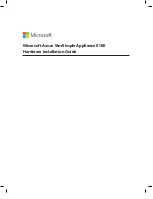
27-2
Cisco ME 3800X and 3600X Switch Software Configuration Guide
OL-23400-01
Chapter 27 Configuring QoS
Understanding QoS
Understanding QoS
When networks operate on a best-effort delivery basis, all traffic has equal priority and an equal chance
of being delivered in a timely manner. When congestion occurs, all traffic has an equal chance of being
dropped. When you configure QoS, you can select specific network traffic, prioritize it according to its
relative importance, and use traffic-management techniques to provide preferential treatment.
Implementing QoS in your network makes network performance more predictable and bandwidth
utilization more effective.
Figure 27-1
shows the MQC model.
Figure 27-1
Modular QoS CLI Model
Basic QoS includes these actions.
•
Packet classification organizes traffic on the basis of whether or not the traffic matches a specific
criteria. When a packet is received, the switch identifies all key packet fields: CoS, DSCP, IP
precedence, or MPLS EXP. The switch classifies the packet based on this content or based on an
ACL lookup. The class class-default is used in a policy map for any traffic that does not explicitly
match any other class in the policy map. See the
“Classification” section on page 27-5
.
•
Packet policing determines whether a packet is in or out of profile by comparing the rate of the
incoming traffic to the configured policer. You can configure a committed information rate (CIR)
and peak information rate (PIR) and set actions to perform on packets that conform to the CIR and
PIR (conform-action), packets that conform to the PIR, but not the CIR (exceed-action), and packets
that exceed the PIR value (violate-action). See the
“Policing” section on page 27-13
.
•
All packets that belong to a classification can be remarked. When you configure a policer, packets
that meet or exceed the permitted bandwidth requirements (bits per second) can be conditionally
passed through, dropped, or marked. You use the police command to conditionally mark incoming
packets based on the CIR and PIR. You use the set command to unconditionally mark packets. See
the
“Marking” section on page 27-14
.
•
Congestion management uses queuing and scheduling algorithms to queue and sort traffic that is
leaving a port. The switch supports these scheduling and traffic-limiting features: class-based
weighted fair queuing (CBWFQ), class-based traffic shaping, port shaping, and class-based priority
queuing. You can provide guaranteed bandwidth to a particular class of traffic while still servicing
other traffic queues. See the
“Congestion Management and Scheduling” section on page 27-17
.
•
Queuing on the switch uses the WTD algorithm, a congestion-avoidance mechanism. WTD
differentiates traffic classes and regulates the queue size based on the classification. See the
“Congestion Avoidance and Queuing” section on page 27-15
.
This section includes information about these topics:
•
Modular QoS CLI Configuration, page 27-3
Classification
Policing
Marking
Congestion
Avoidance
Queuing
Scheduling
Congestion
Drops
Policer
Drops
141149
















































